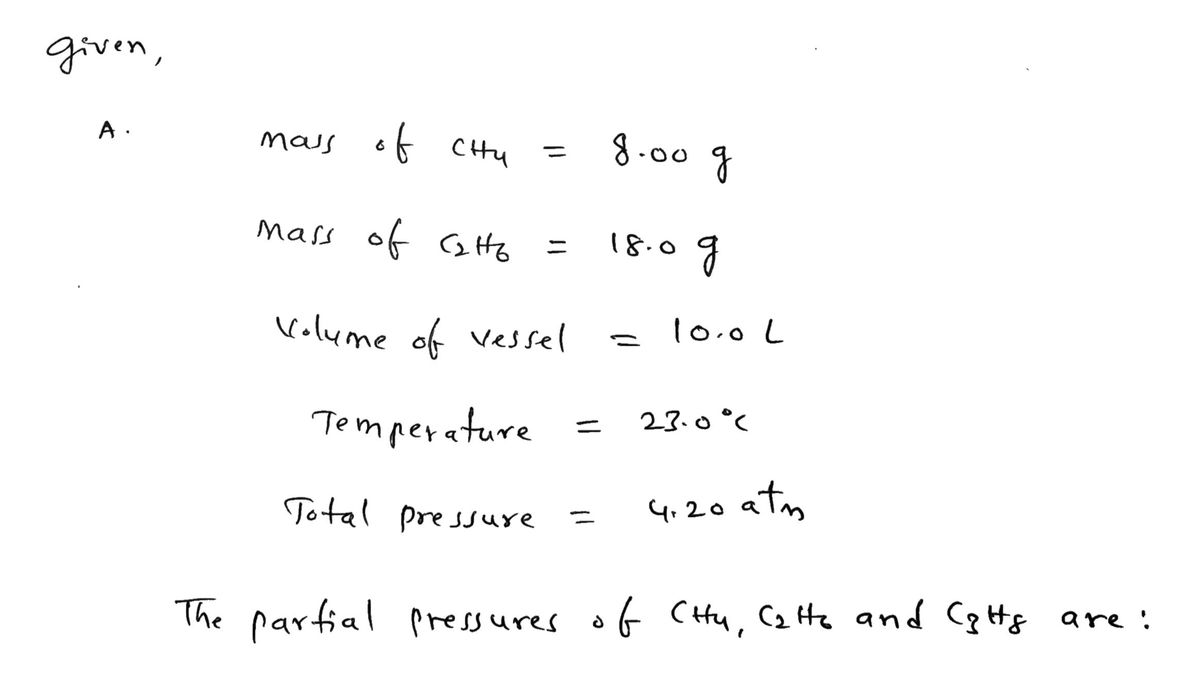Dalton's law states that the total pressure, Ptotal of a mixture of gases in a container equals the sum of the pressures of each individual gas: Ptotal= P₁+P₂ + P3+... The partial pressure of the first component, P₁, is equal to the mole fraction of this component, X₁, times the total pressure of the mixture: P₁ = X₁ x Ptotal The mole fraction, X, represents the concentration of the component in the gas mixture, so X₁ = moles of component 1 total moles in mixture Part A Three gases (8.00 g of methane, CH,. 18.0 g of ethane, C₂H. and an unknown amount of propane, C3Hs) were added to the same 10.0-L container. At 23.0 °C, the total pressure in the container is 4,20 atm. Calculate the partial pressure of each gas in the container. Express the pressure values numerically in atmospheres, separated by commas. Enter the partial pressure of methane first, then ethane, then propane. View Available Hint(s) Pmethane Pethane Ppropane Submit Part B Poxygen = I Π ΑΣΦ 3 A C 15. ΑΣΦ A gaseous mixture of O₂ and N₂ contains 39.8 % nitrogen by mass. What is the partial pressure of oxygen in the mixture if the total pressure is 845 mmHg? Express you answer numerically in millimeters of mercury. ▸ View Available Hint(s) 3 → C ? ? mmHg atm 4
Dalton's law states that the total pressure, Ptotal of a mixture of gases in a container equals the sum of the pressures of each individual gas: Ptotal= P₁+P₂ + P3+... The partial pressure of the first component, P₁, is equal to the mole fraction of this component, X₁, times the total pressure of the mixture: P₁ = X₁ x Ptotal The mole fraction, X, represents the concentration of the component in the gas mixture, so X₁ = moles of component 1 total moles in mixture Part A Three gases (8.00 g of methane, CH,. 18.0 g of ethane, C₂H. and an unknown amount of propane, C3Hs) were added to the same 10.0-L container. At 23.0 °C, the total pressure in the container is 4,20 atm. Calculate the partial pressure of each gas in the container. Express the pressure values numerically in atmospheres, separated by commas. Enter the partial pressure of methane first, then ethane, then propane. View Available Hint(s) Pmethane Pethane Ppropane Submit Part B Poxygen = I Π ΑΣΦ 3 A C 15. ΑΣΦ A gaseous mixture of O₂ and N₂ contains 39.8 % nitrogen by mass. What is the partial pressure of oxygen in the mixture if the total pressure is 845 mmHg? Express you answer numerically in millimeters of mercury. ▸ View Available Hint(s) 3 → C ? ? mmHg atm 4
Chemistry
10th Edition
ISBN:9781305957404
Author:Steven S. Zumdahl, Susan A. Zumdahl, Donald J. DeCoste
Publisher:Steven S. Zumdahl, Susan A. Zumdahl, Donald J. DeCoste
Chapter1: Chemical Foundations
Section: Chapter Questions
Problem 1RQ: Define and explain the differences between the following terms. a. law and theory b. theory and...
Related questions
Question
Help me solve part A and B

Transcribed Image Text:Dalton's law states that the total pressure, Ptotal of a
mixture of gases in a container equals the sum of the
pressures of each individual gas:
Ptotal
= P₁+P+ P3+...
The partial pressure of the first component, P₁, is equal
to the mole fraction of this component, X₁, times the
total pressure of the mixture:
P₁ = X₁ X Ptotal
The mole fraction, X, represents the concentration of
the component in the gas mixture, so
X₁
-
moles of component 1
total moles in mixture
▼
▼
Part A
Three gases (8.00 g of methane, CH, 18.0 g of ethane, C₂H6, and an unknown amount of propane, C3Hg) were added to the same
10.0-L container. At 23.0 °C, the total pressure in the container is 4.20 atm. Calculate the partial pressure of each gas in the container.
Express the pressure values numerically in atmospheres, separated by commas. Enter the partial pressure of methane first,
then ethane, then propane.
►View Available Hint(s)
Pmethane, Pethane, Ppropane
Submit
Part B
Poxygen =
1
15. ΑΣΦ
Π ΑΣΦ
A gaseous mixture of O2 and N₂ contains 39.8 % nitrogen by mass. What is the partial pressure of oxygen in the mixture if the total
pressure is 845 mmHg?
Express you answer numerically in millimeters of mercury.
► View Available Hint(s)
?
mmHg
atm
Expert Solution
Step 1

Step by step
Solved in 7 steps with 7 images

Knowledge Booster
Learn more about
Need a deep-dive on the concept behind this application? Look no further. Learn more about this topic, chemistry and related others by exploring similar questions and additional content below.Recommended textbooks for you

Chemistry
Chemistry
ISBN:
9781305957404
Author:
Steven S. Zumdahl, Susan A. Zumdahl, Donald J. DeCoste
Publisher:
Cengage Learning

Chemistry
Chemistry
ISBN:
9781259911156
Author:
Raymond Chang Dr., Jason Overby Professor
Publisher:
McGraw-Hill Education

Principles of Instrumental Analysis
Chemistry
ISBN:
9781305577213
Author:
Douglas A. Skoog, F. James Holler, Stanley R. Crouch
Publisher:
Cengage Learning

Chemistry
Chemistry
ISBN:
9781305957404
Author:
Steven S. Zumdahl, Susan A. Zumdahl, Donald J. DeCoste
Publisher:
Cengage Learning

Chemistry
Chemistry
ISBN:
9781259911156
Author:
Raymond Chang Dr., Jason Overby Professor
Publisher:
McGraw-Hill Education

Principles of Instrumental Analysis
Chemistry
ISBN:
9781305577213
Author:
Douglas A. Skoog, F. James Holler, Stanley R. Crouch
Publisher:
Cengage Learning

Organic Chemistry
Chemistry
ISBN:
9780078021558
Author:
Janice Gorzynski Smith Dr.
Publisher:
McGraw-Hill Education

Chemistry: Principles and Reactions
Chemistry
ISBN:
9781305079373
Author:
William L. Masterton, Cecile N. Hurley
Publisher:
Cengage Learning

Elementary Principles of Chemical Processes, Bind…
Chemistry
ISBN:
9781118431221
Author:
Richard M. Felder, Ronald W. Rousseau, Lisa G. Bullard
Publisher:
WILEY